Dual Effects of Marine Heatwaves on Typhoon Intensity and Associated Heat Dissipation
Abstract
1. Introduction
2. Data and Methods
2.1. Typhoon Information
2.2. MHWs Analysis
2.3. Oceanic and Atmospheric Parameters
2.4. Spatial and Temporal Analysis
3. Results
3.1. Dual Effects of MHWs on Typhoon Intensity and Associated Heat Dissipation
3.2. Interaction Between MHWs and Typhoons: Case Study
3.2.1. Typhoon Hinnamnor (2022) and Its Interaction with MHWs
3.2.2. Typhoon Mawar’s Evolution and MHW Interaction
3.2.3. Typhoon Koinu’s Evolution and MHW Interaction
3.3. Role of Subsurface Temperature and Heat Content: Case Study
3.3.1. Subsurface Ocean Characteristics During Typhoon Hinnamnor (2022) Development
3.3.2. Subsurface Ocean Characteristics During Typhoon Mawar (2023) Development
3.3.3. Subsurface Ocean Characteristics During Typhoon Koinu (2023) Development
3.4. Role of Ocean Stratification: Case Study
3.4.1. Ocean Stratification During Typhoon Hinnamnor (2022) Development
3.4.2. Ocean Stratification During Typhoon Mawar (2023) Development
3.4.3. Ocean Stratification During Typhoon Koinu (2023) Development
3.5. Air–Sea Heat Flux: Case Study
4. Discussion
4.1. Feedback Mechanism Between MHWs and Subsurface Ocean Conditions
4.2. Feedback Mechanism Between MHWs and Air–Sea Heat Fluxes
5. Conclusions
Author Contributions
Funding
Data Availability Statement
Acknowledgments
Conflicts of Interest
Abbreviations
| CMEMS | Copernicus Marine Environment Monitoring Service |
| D26 | Depth of the 26 °C isotherm |
| ENSO | El Niño-Southern Oscillation |
| ECS | East China Sea |
| ECMWF | European Centre for Medium-Range Weather Forecasts |
| JMA | Japan Meteorological Agency |
| MHWs | Marine heatwaves |
| MLD | Mixed layer depth |
| NCEI | National Centers for Environmental Information |
| NOAA | National Oceanic and Atmospheric Administration |
| NWP | Northwestern Pacific |
| OHC | Ocean heat content |
| PDO | Pacific Decadal Oscillation |
| R30 | Outer-core region (radii of 30 knots) |
| R50 | Inner-core region (radii of 50 knots) |
| SCS | South China Sea |
| SST | Sea surface temperature |
| Mean upper 100 m temperature | |
| WOA18 | World Ocean Atlas 2018 |
References
- Hobday, A.J.; Alexander, L.V.; Perkins, S.E.; Smale, D.A.; Straub, S.C.; Oliver, E.C.; Benthuysen, J.A.; Burrows, M.T.; Donat, M.G.; Feng, M.; et al. A hierarchical approach to defining marine heatwaves. Prog. Oceanogr. 2016, 141, 227–238. [Google Scholar] [CrossRef]
- Oliver, E.C.; Donat, M.G.; Burrows, M.T.; Moore, P.J.; Smale, D.A.; Alexander, L.V.; Benthuysen, J.A.; Feng, M.; Gupta, A.S.; Hobday, A.J.; et al. Longer and more frequent marine heatwaves over the past century. Nat. Commun. 2018, 9, 1324. [Google Scholar] [CrossRef]
- Sen Gupta, A.; Thomsen, M.; Benthuysen, J.A.; Hobday, A.J.; Oliver, E.; Alexander, L.V.; Burrows, M.T.; Donat, M.G.; Feng, M.; Holbrook, N.J.; et al. Drivers and impacts of the most extreme marine heatwave events. Sci. Rep. 2020, 10, 19359. [Google Scholar] [CrossRef]
- Hsu, P.C.; Macagga, R.A.T.; Lu, C.Y.; Lo, D.Y.J. Investigation of the Kuroshio-coastal current interaction and marine heatwave trends in the coral habitats of Northeastern Taiwan. Reg. Stud. Mar. Sci. 2024, 71, 103431. [Google Scholar] [CrossRef]
- Hsu, P.C.; Macagga, R.A.T.; Raj, R.P. Assessment of the impacts of rapid Marine Heatwaves and cumulative thermal stress on cold-water upwelling coral refugia. Geomat. Nat. Hazards Risk 2025, 16, 2448240. [Google Scholar] [CrossRef]
- Holbrook, N.J.; Scannell, H.A.; Sen Gupta, A.; Benthuysen, J.A.; Feng, M.; Oliver, E.C.; Alexander, L.V.; Burrows, M.T.; Donat, M.G.; Hobday, A.J.; et al. A global assessment of marine heatwaves and their drivers. Nat. Commun. 2019, 10, 2624. [Google Scholar] [CrossRef]
- Myers, T.A.; Mechoso, C.R.; Cesana, G.V.; DeFlorio, M.J.; Waliser, D.E. Cloud feedback key to marine heatwave off Baja California. Geophys. Res. Lett. 2018, 45, 4345–4352. [Google Scholar] [CrossRef]
- Chen, Q.; Li, D.; Feng, J.; Zhao, L.; Qi, J.; Yin, B. Understanding the compound marine heatwave and low-chlorophyll extremes in the western Pacific Ocean. Front. Mar. Sci. 2023, 10, 1303663. [Google Scholar] [CrossRef]
- Frölicher, T.L.; Fischer, E.M.; Gruber, N. Marine heatwaves under global warming. Nature 2018, 560, 360–364. [Google Scholar] [CrossRef]
- Song, Q.; Yao, Y.; Wang, C. Response of future summer marine heatwaves in the South China Sea to enhanced western Pacific subtropical high. Geophys. Res. Lett. 2023, 50, e2023GL103667. [Google Scholar] [CrossRef]
- Yang, Y.; Sun, W.; Yang, J.; Lim Kam Sian, K.T.; Ji, J.; Dong, C. Analysis and prediction of marine heatwaves in the Western North Pacific and Chinese coastal region. Front. Mar. Sci. 2022, 9, 1048557. [Google Scholar] [CrossRef]
- Xu, J.; Yan, Y.; Zhang, L.; Xing, W.; Meng, L.; Yu, Y.; Chen, C. Long-term trends and extreme events of marine heatwaves in the Eastern China Marginal Seas during summer. Front. Mar. Sci. 2024, 11, 1380963. [Google Scholar] [CrossRef]
- Emanuel, K. Tropical cyclones. Annu. Rev. Earth Planet. Sci. 2003, 31, 75–104. [Google Scholar] [CrossRef]
- Cione, J.J. The relative roles of the ocean and atmosphere as revealed by buoy air–sea observations in hurricanes. Mon. Weather Rev. 2015, 143, 904–913. [Google Scholar] [CrossRef]
- Cione, J.J.; Uhlhorn, E.W. Sea surface temperature variability in hurricanes: Implications with respect to intensity change. Mon. Weather Rev. 2003, 131, 1783–1796. [Google Scholar] [CrossRef]
- Huang, P.; Lin, I.I.; Chou, C.; Huang, R.H. Change in ocean subsurface environment to suppress tropical cyclone intensification under global warming. Nat. Commun. 2015, 6, 7188. [Google Scholar] [CrossRef] [PubMed]
- Lin, I.I.; Pun, I.F.; Lien, C.C. “Category-6” supertyphoon Haiyan in global warming hiatus: Contribution from subsurface ocean warming. Geophys. Res. Lett. 2014, 41, 8547–8553. [Google Scholar] [CrossRef]
- Kataoka, T.; Tozuka, T.; Yamagata, T. Generation and decay mechanisms of Ningaloo Niño/Niña. J. Geophys. Res. Ocean. 2017, 122, 8913–8932. [Google Scholar] [CrossRef]
- Dzwonkowski, B.; Coogan, J.; Fournier, S.; Lockridge, G.; Park, K.; Lee, T. Compounding impact of severe weather events fuels marine heatwave in the coastal ocean. Nat. Commun. 2020, 11, 4623. [Google Scholar] [CrossRef]
- Oh, H.; Kim, G.U.; Chu, J.E.; Lee, K.; Jeong, J.Y. The record-breaking 2022 long-lasting marine heatwaves in the East China Sea. Environ. Res. Lett. 2023, 18, 064015. [Google Scholar] [CrossRef]
- Choi, H.Y.; Park, M.S.; Kim, H.S.; Lee, S. Marine heatwave events strengthen the intensity of tropical cyclones. Commun. Earth Environ. 2024, 5, 69. [Google Scholar] [CrossRef]
- Gao, G.; Marin, M.; Feng, M.; Yin, B.; Yang, D.; Feng, X.; Ding, Y.; Song, D. Drivers of marine heatwaves in the East China Sea and the South Yellow Sea in three consecutive summers during 2016–2018. J. Geophys. Res. Ocean. 2020, 125, e2020JC016518. [Google Scholar] [CrossRef]
- Pun, I.F.; Hsu, H.H.; Moon, I.J.; Lin, I.I.; Jeong, J.Y. Marine heatwave as a supercharger for the strongest typhoon in the East China Sea. npj Clim. Atmos. Sci. 2023, 6, 128. [Google Scholar] [CrossRef]
- Rathore, S.; Goyal, R.; Jangir, B.; Ummenhofer, C.C.; Feng, M.; Mishra, M. Interactions between a marine heatwave and Tropical Cyclone Amphan in the Bay of Bengal in 2020. Front. Clim. 2022, 4, 861477. [Google Scholar] [CrossRef]
- Lee, S.; Park, M.S.; Kwon, M.; Park, Y.G.; Kim, Y.H.; Choi, N. Rapidly changing East Asian marine heatwaves under a warming climate. J. Geophys. Res. Ocean. 2023, 128, e2023JC019761. [Google Scholar] [CrossRef]
- Yao, Y.; Wang, C. Variations in summer marine heatwaves in the South China Sea. J. Geophys. Res. Ocean. 2021, 126, e2021JC017792. [Google Scholar] [CrossRef]
- Tan, H.J.; Cai, R.S.; Wu, R.G. Summer marine heatwaves in the South China Sea: Trend, variability and possible causes. Adv. Clim. Change Res. 2022, 13, 323–332. [Google Scholar] [CrossRef]
- Yao, Y.; Wang, C.; Wang, C. Record-breaking 2020 summer marine heatwaves in the western North Pacific. Deep Sea Res. Part II Top. Stud. Oceanogr. 2023, 209, 105288. [Google Scholar] [CrossRef]
- Han, T.; Xu, K.; Wang, L.; Liu, B.; Tam, C.Y.; Liu, K.; Wang, W. Extremely long-lived marine heatwave in South China Sea during summer 2020: Combined effects of the seasonal and intraseasonal variations. Glob. Planet. Change 2023, 230, 104261. [Google Scholar] [CrossRef]
- Hobday, A.J.; Oliver, E.C.J.; Gupta, A.S.; Benthuysen, J.A.; Burrows, M.T.; Donat, M.G.; Holbrook, N.J.; Moore, P.J.; Thomsen, M.S.; Wernberg, T.; et al. Categorizing and naming marine heatwaves. Oceanography 2018, 31, 162–173. Available online: https://www.jstor.org/stable/26542662 (accessed on 25 December 2024). [CrossRef]
- Taburet, G.; Sanchez-Roman, A.; Ballarotta, M.; Pujol, M.-I.; Legeais, J.-F.; Fournier, F.; Faugere, Y.; Dibarboure, G. DUACS DT2018: 25 years of reprocessed sea level altimetry products. Ocean Sci. 2019, 15, 1207–1224. [Google Scholar] [CrossRef]
- Artana, C.; Ferrari, R.; Bricaud, C.; Lellouche, J.-M.; Garric, G.; Sennéchael, N.; Lee, J.-H.; Park, Y.-H.; Provost, C. Twenty-five years of Mercator ocean reanalysis GLORYS12 at Drake Passage: Velocity assessment and total volume transport. Adv. Space Res. 2021, 68, 447–466. [Google Scholar] [CrossRef]
- Jean-Michel, L.; Eric, G.; Romain, B.-B.; Gilles, G.; Angélique, M.; Marie, D.; Clément, B.; Mathieu, H.; Olivier, L.G.; Charly, R.; et al. The Copernicus global 1/12 oceanic and sea ice GLORYS12 reanalysis. Front. Earth Sci. 2021, 9, 698876. [Google Scholar] [CrossRef]
- Locarnini, M.M.; Mishonov, A.V.; Baranova, O.K.; Boyer, T.P.; Zweng, M.M.; Garcia, H.E.; Reagan, J.; Seidov, D.; Weathers, K.W.; Paver, C.R.; et al. World Ocean Atlas 2018, Volume 1: Temperature. 2018, Ref. NOAA Atlas NESDIS 81, 52p. A. Mishonov Technical Editor. Available online: https://archimer.ifremer.fr/doc/00651/76338/ (accessed on 25 December 2024).
- Cucchi, M.; Weedon, G.P.; Amici, A.; Bellouin, N.; Lange, S.; Schmied, H.M.; Hersbach, H.; Buontempo, C. WFDE5: Bias-adjusted ERA5 reanalysis data for impact studies. Earth Syst. Sci. Data 2020, 12, 2097–2120. [Google Scholar] [CrossRef]
- Hersbach, H.; Bell, B.; Berrisford, P.; Hirahara, S.; Horányi, A.; Muñoz-Sabater, J.; Nicolas, J.; Peubey, C.; Radu, R.; Schepers, D.; et al. The ERA5 global reanalysis. Q. J. R. Meteorol. Soc. 2020, 146, 1999–2049. [Google Scholar] [CrossRef]
- Hsu, P.C.; Ho, C.R. Typhoon-induced ocean subsurface variations from glider data in the Kuroshio region adjacent to Taiwan. J. Oceanogr. 2019, 75, 1–21. [Google Scholar] [CrossRef]
- Ha, K.J.; Moon, S.; Timmermann, A.; Kim, D. Future changes of summer monsoon characteristics and evaporative demand over Asia in CMIP6 simulations. Geophys. Res. Lett. 2020, 47, e2020GL087492. [Google Scholar] [CrossRef]
- Moon, S.; Ha, K.J. Future changes in monsoon duration and precipitation using CMIP6. npj Clim. Atmos. Sci. 2020, 3, 45. [Google Scholar] [CrossRef]
- Benthuysen, J.A.; Smith, G.A.; Spillman, C.M.; Steinberg, C.R. Subseasonal prediction of the 2020 Great Barrier Reef and Coral Sea marine heatwave. Environ. Res. Lett. 2021, 16, 124050. [Google Scholar] [CrossRef]
- Scannell, H.A.; Johnson, G.C.; Thompson, L.; Lyman, J.M.; Riser, S.C. Subsurface evolution and persistence of marine heatwaves in the Northeast Pacific. Geophys. Res. Lett. 2020, 47, e2020GL090548. [Google Scholar] [CrossRef]
- Li, G.; Cheng, L.; Zhu, J.; Trenberth, K.E.; Mann, M.E.; Abraham, J.P. Increasing ocean stratification over the past half-century. Nat. Clim. Change 2020, 10, 1116–1123. [Google Scholar] [CrossRef]
- Jacox, M.G.; Hazen, E.L.; Zaba, K.D.; Rudnick, D.L.; Edwards, C.A.; Moore, A.M.; Bograd, S.J. Impacts of the 2015–2016 El Niño on the California Current System: Early assessment and comparison to past events. Geophys. Res. Lett. 2016, 43, 7072–7080. [Google Scholar] [CrossRef]
- Smale, D.A.; Wernberg, T.; Oliver, E.C.J.; Thomsen, M.; Harvey, B.P.; Straub, S.C.; Burrows, M.T.; Alexander, L.V.; Benthuysen, J.A.; Donat, M.G.; et al. Marine heatwaves threaten global biodiversity and the provision of ecosystem services. Nat. Clim. Change 2019, 9, 306–312. [Google Scholar] [CrossRef]
- Holbrook, N.J.; Gupta, A.S.; Oliver, E.C.J.; Hobday, A.J.; Benthuysen, J.A.; Scannell, H.A.; Smale, D.A.; Wernberg, T. Keeping pace with marine heatwaves. Nat. Rev. Earth Environ. 2020, 1, 482–493. [Google Scholar] [CrossRef]
- Liu, K.; Xu, K.; Zhu, C.; Liu, B. Diversity of marine heatwaves in the South China Sea regulated by ENSO phase. J. Clim. 2022, 35, 877–893. [Google Scholar] [CrossRef]
- Oliver, E.C.; Benthuysen, J.A.; Bindoff, N.L.; Hobday, A.J.; Holbrook, N.J.; Mundy, C.N.; Perkins-Kirkpatrick, S.E. The unprecedented 2015/16 Tasman Sea marine heatwave. Nat. Commun. 2017, 8, 16101. [Google Scholar] [CrossRef]
- Benthuysen, J.A.; Oliver, E.C.; Feng, M.; Marshall, A.G. Extreme marine warming across tropical Australia during austral summer 2015–2016. J. Geophys. Res. Ocean. 2018, 123, 1301–1326. [Google Scholar] [CrossRef]
- Fritz, C.; Wang, Z. Water vapor budget in a developing tropical cyclone and its implication for tropical cyclone formation. J. Atmos. Sci. 2014, 71, 4321–4332. [Google Scholar] [CrossRef]
- Park, M.S.; Elsberry, R.L. Latent heating and cooling rates in developing and nondeveloping tropical disturbances during TCS-08: TRMM PR versus ELDORA retrievals. J. Atmos. Sci. 2013, 70, 15–35. [Google Scholar] [CrossRef]
- Park, M.S.; Elsberry, R.L.; Harr, P.A. Vertical wind shear and ocean heat content as environmental modulators of western North Pacific tropical cyclone intensification and decay. Trop. Cyclone Res. Rev. 2012, 1, 448–457. [Google Scholar] [CrossRef]
- Knutson, T.R.; Sirutis, J.J.; Zhao, M.; Tuleya, R.E.; Bender, M.; Vecchi, G.A.; Villarini, G.; Chavas, D. Global projections of intense tropical cyclone activity for the late twenty-first century from dynamical downscaling of CMIP5/RCP4. 5 scenarios. J. Clim. 2015, 28, 7203–7224. [Google Scholar] [CrossRef]
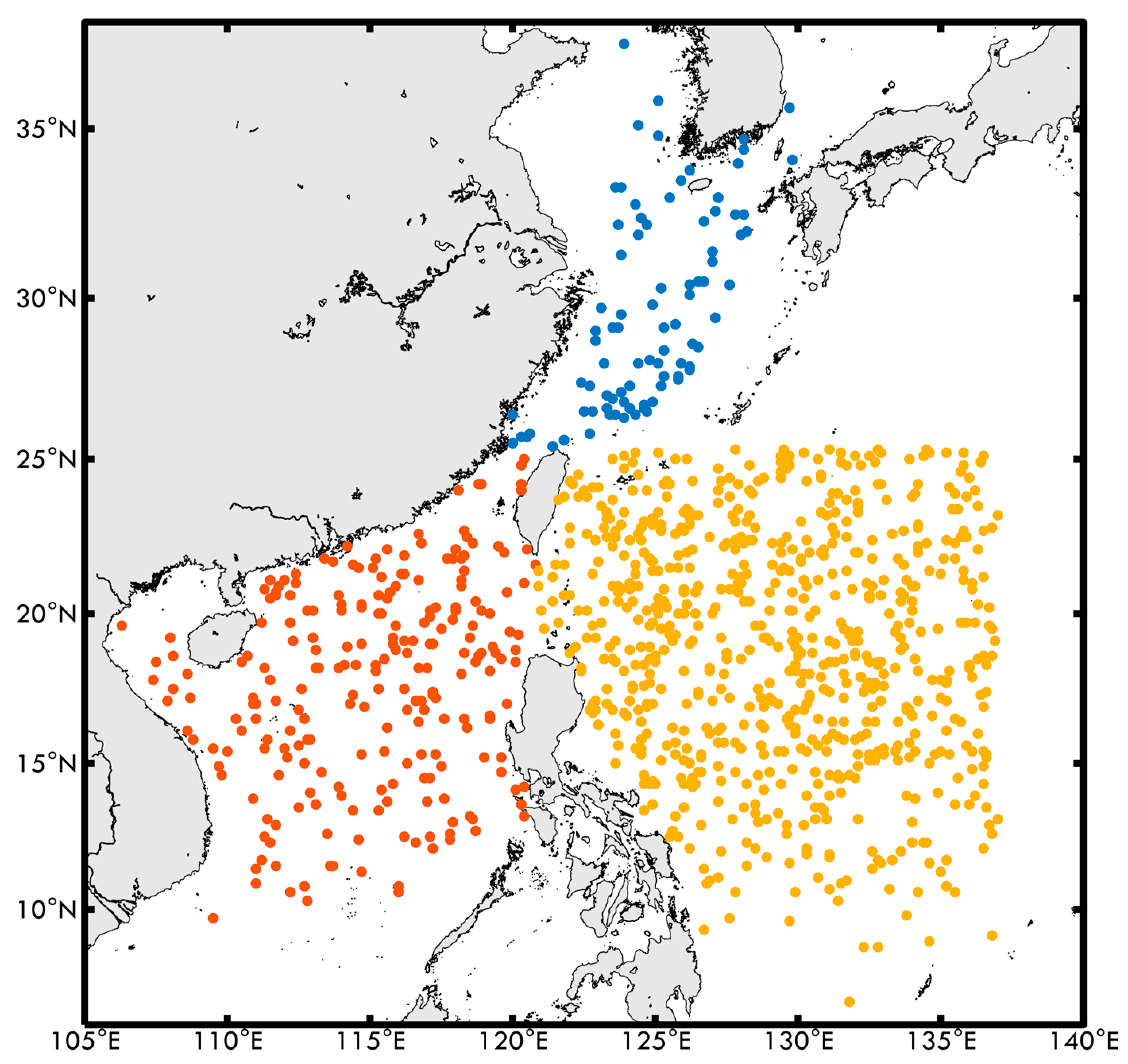
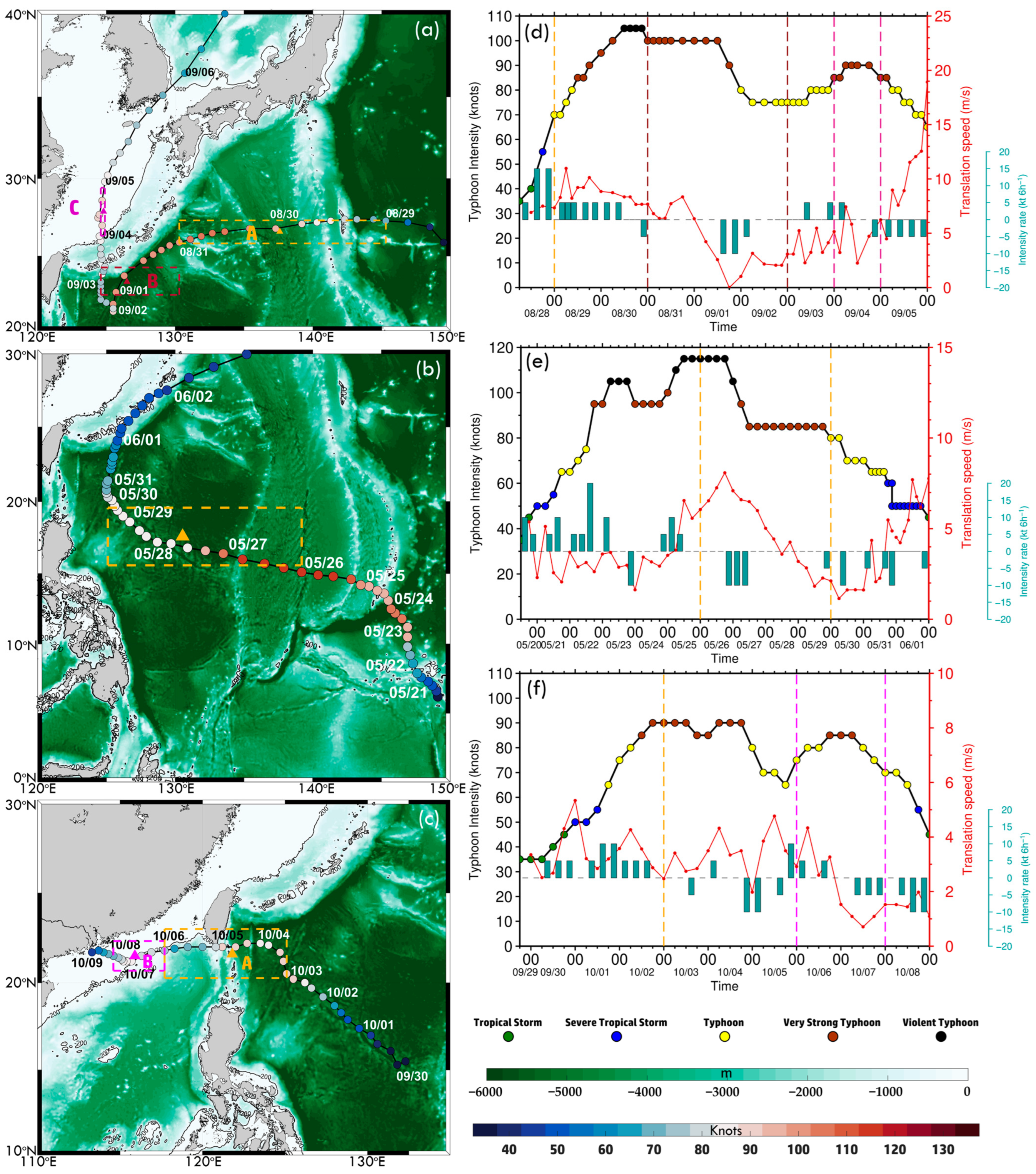
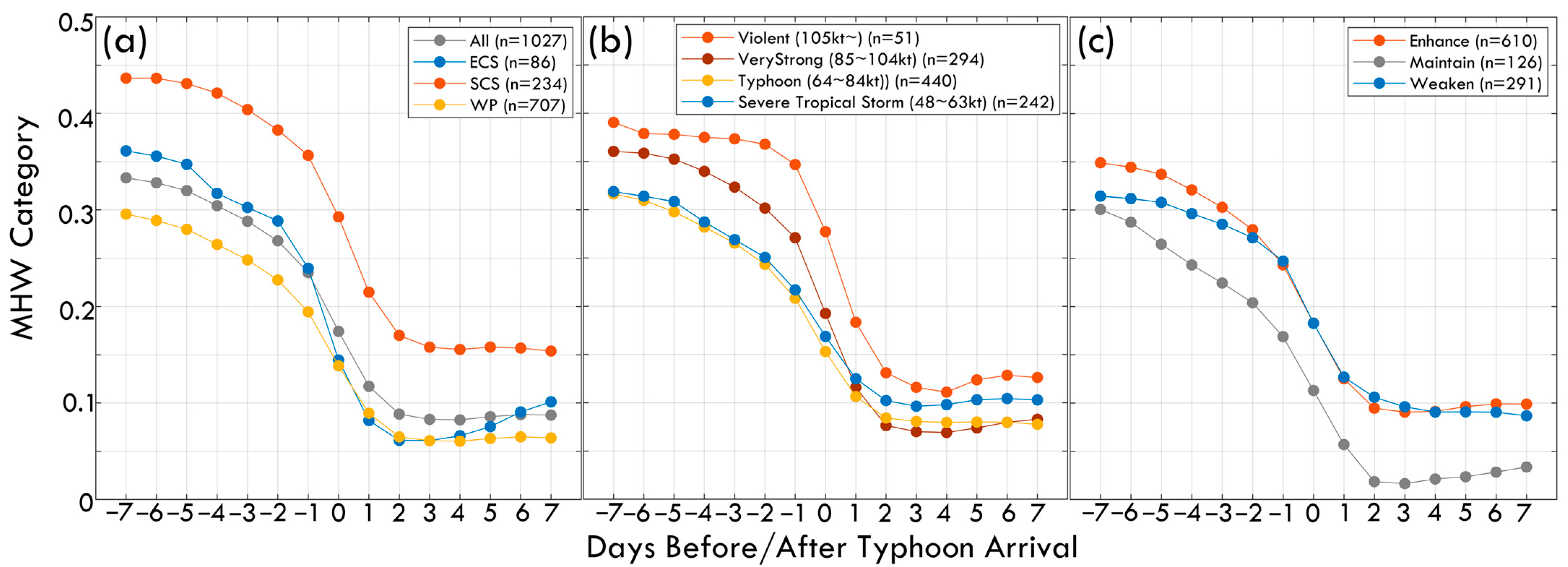

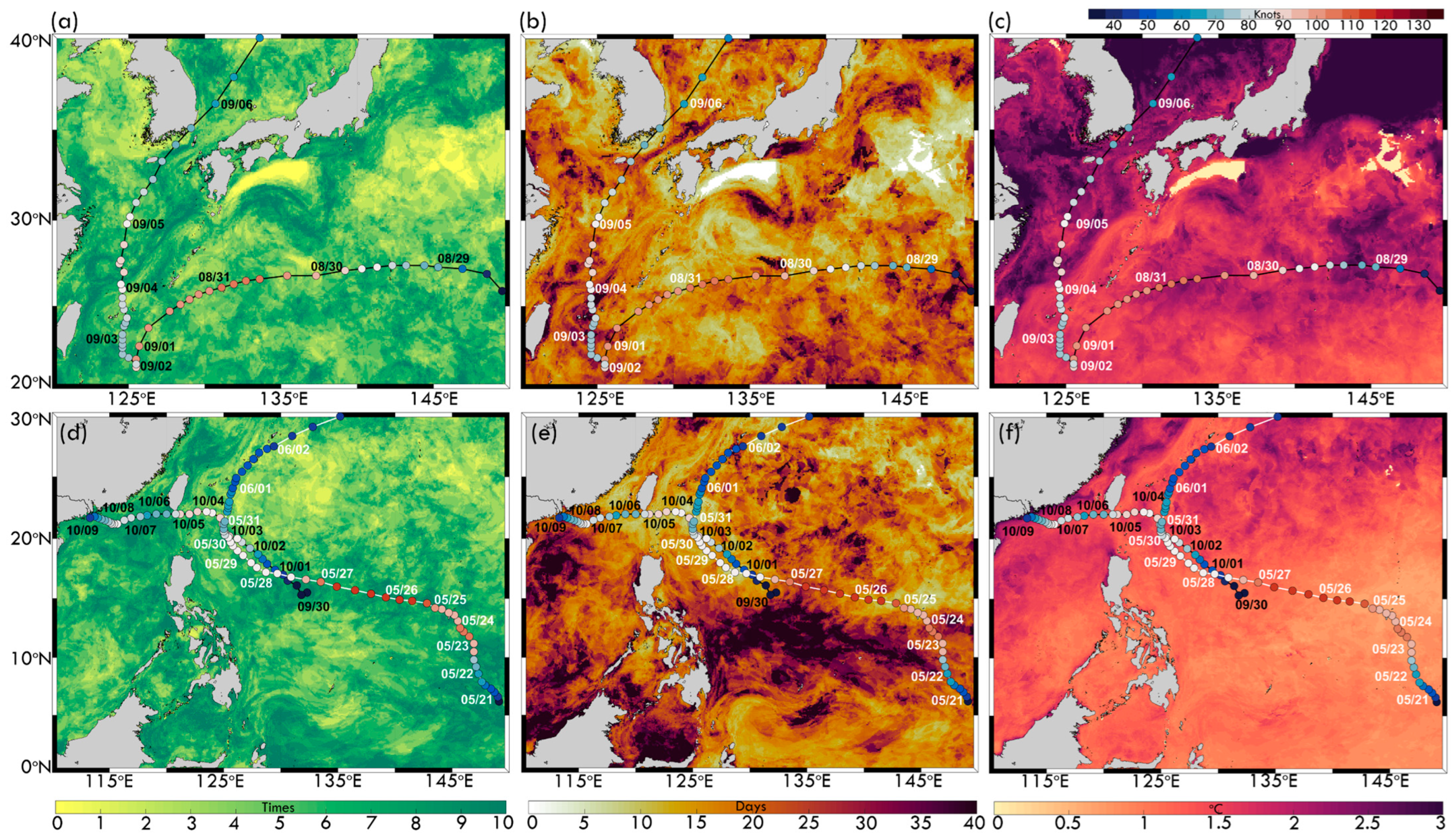


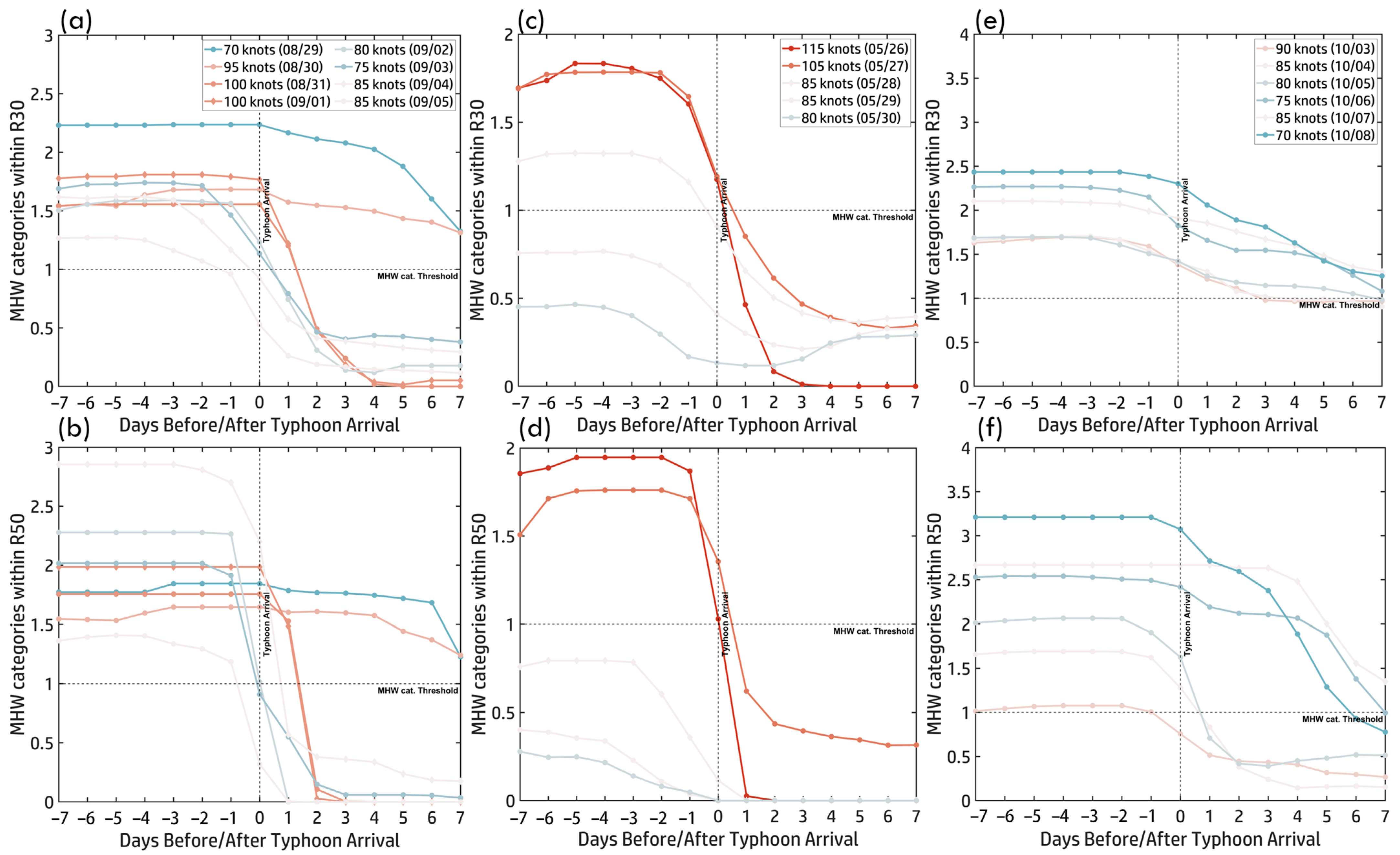

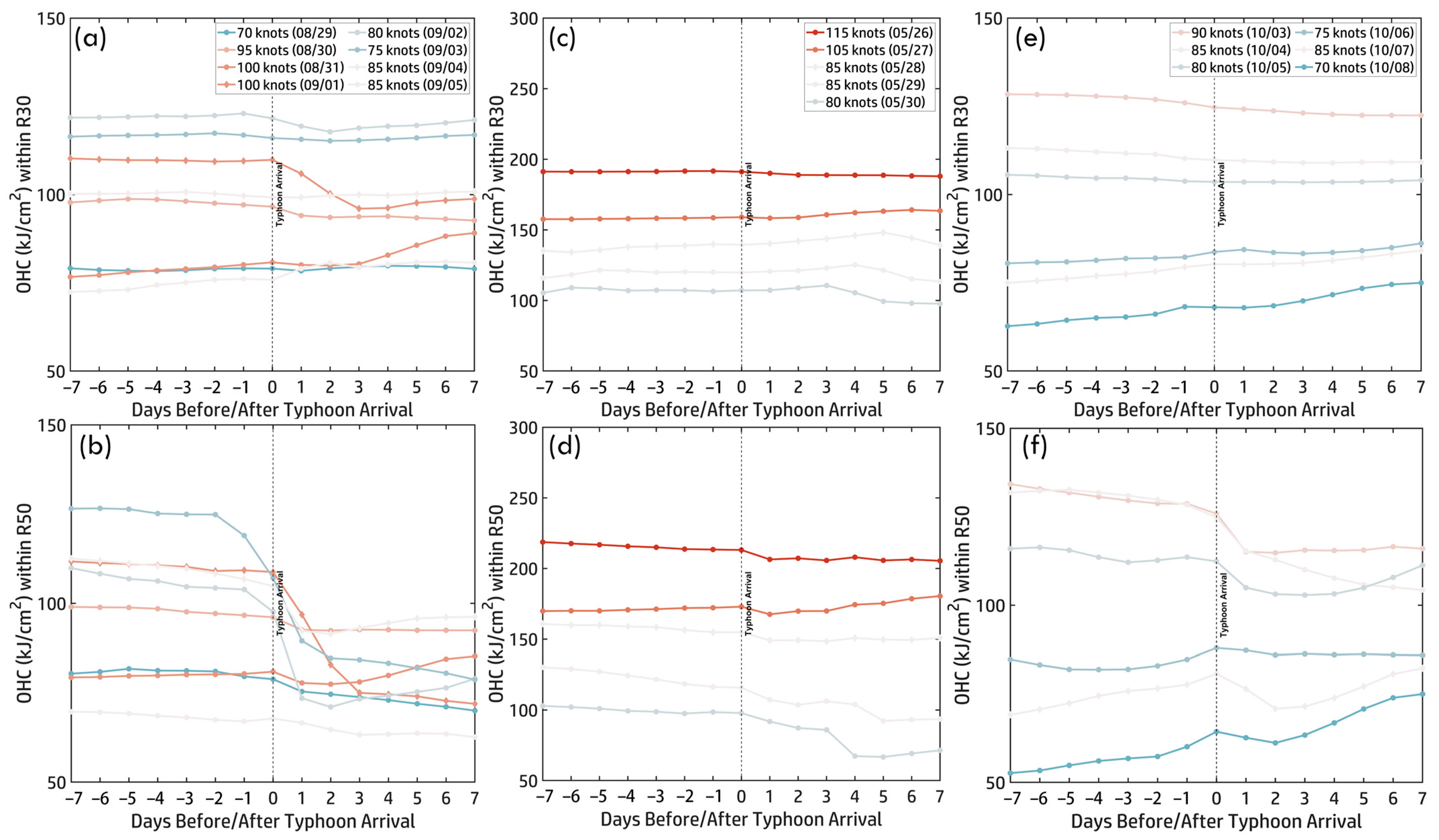
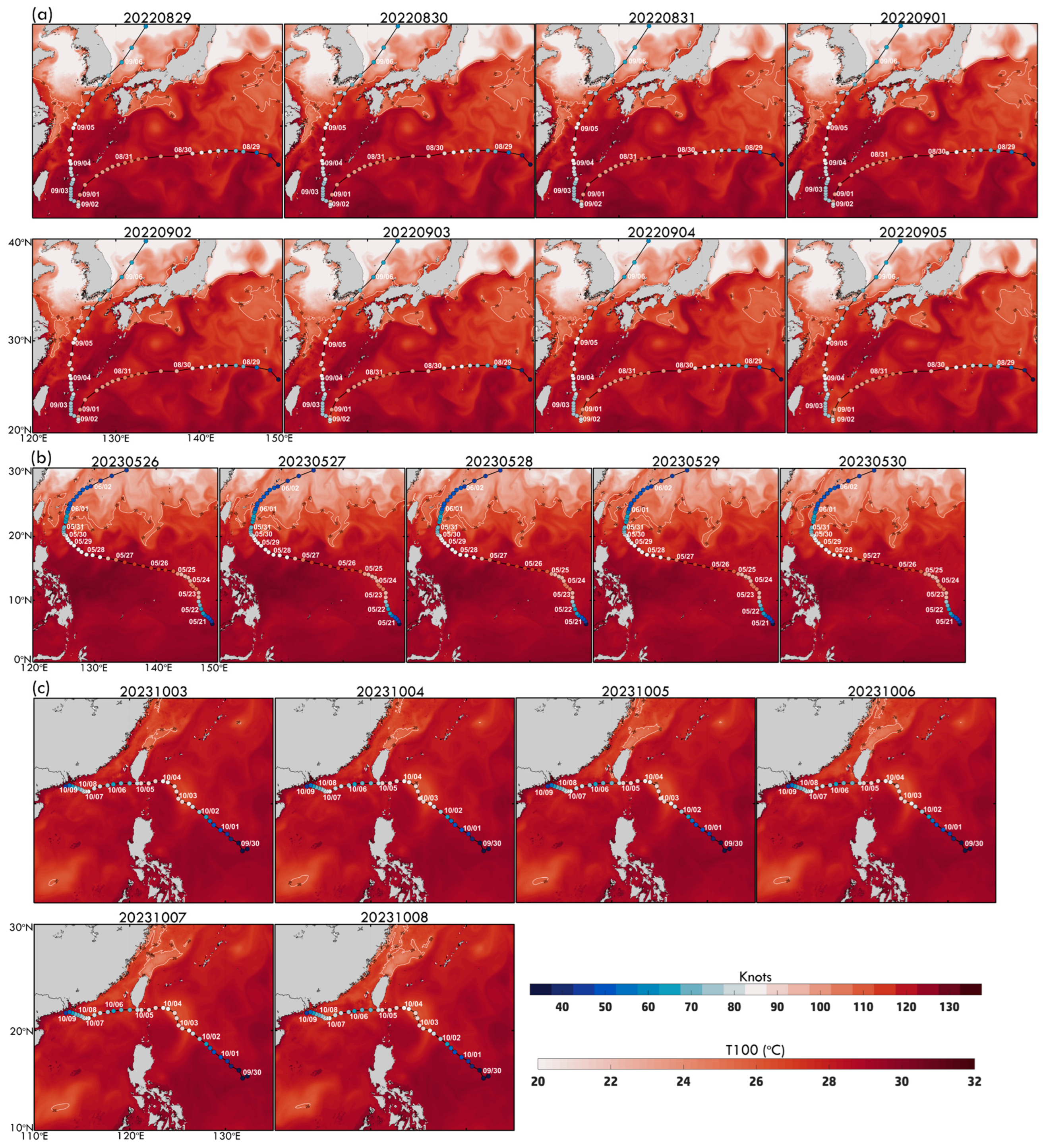
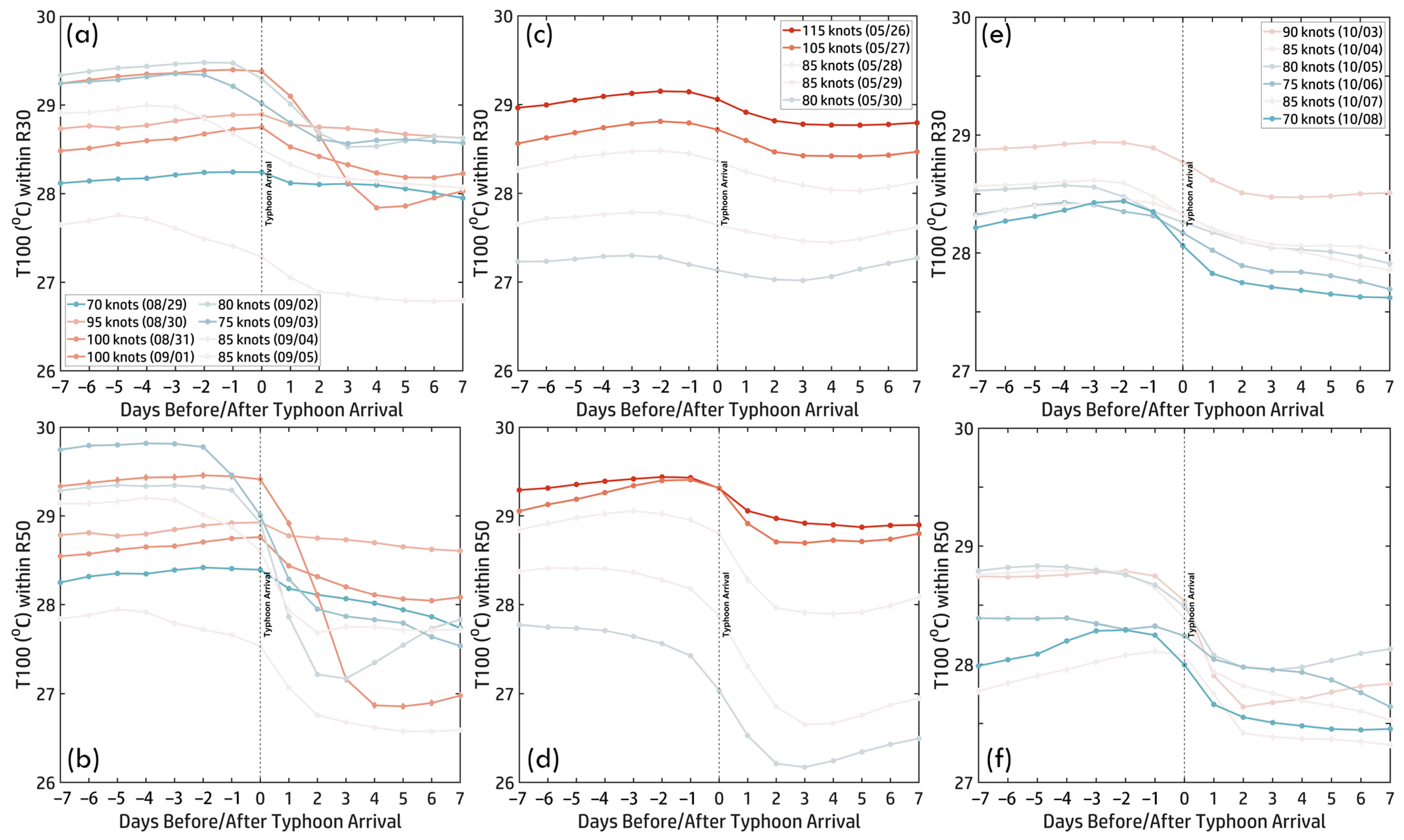



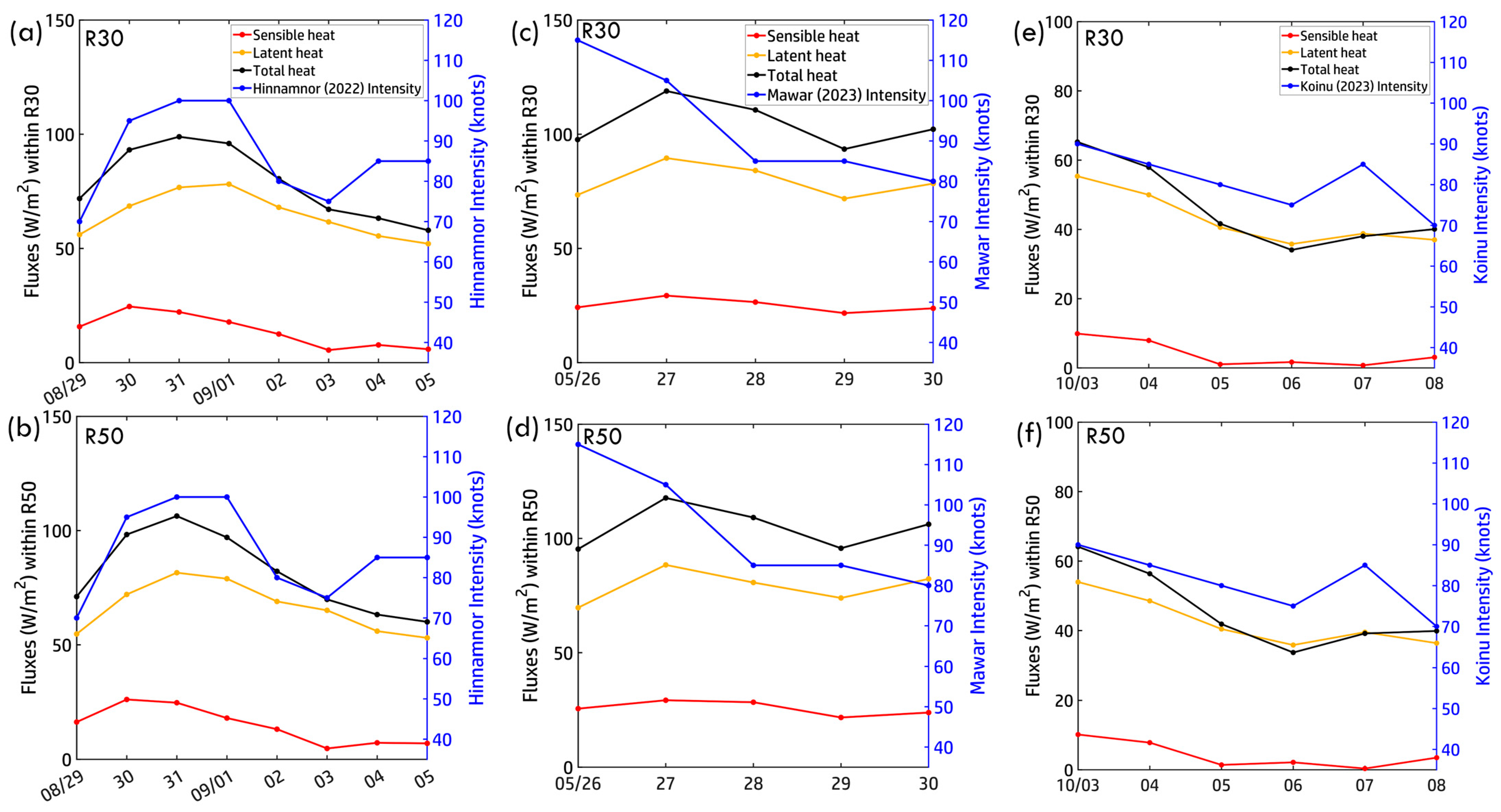
| All Case | ECS | SCS | WP | |
|---|---|---|---|---|
| All Category | 1027 | 86 | 234 | 707 |
|
Severe Tropical Storm
(48 ≤ knots < 64) | 242 | 25 | 98 | 119 |
|
Typhoon
(64 ≤ knots < 85) | 440 | 43 | 111 | 286 |
|
Very Strong Typhoon
(85 ≤ knots < 105) | 294 | 18 | 22 | 254 |
|
Violent Typhoon
(105 ≤ knots) | 51 | 0 | 3 | 48 |
| Typhoons | Time (YYYY/MM/DD) | Longitude (°E) | Latitude (°N) | Intensity (Knots) | Intensity Changed (Knots/Day) | R50 (nm) | R30 (nm) |
|---|---|---|---|---|---|---|---|
| Hinnamnor (2022) | 2022/08/29 | 145.3 | 27.3 | 70 | --- | 30 | 120 |
| 2022/08/30 | 137.3 | 26.7 | 95 | 25 | 50 | 90 | |
| 2022/08/31 | 130.3 | 25.9 | 100 | 5 | 50 | 90 | |
| 2022/09/01 | 125.7 | 22.6 | 100 | 0 | 50 | 120 | |
| 2022/09/02 | 125.5 | 21.5 | 80 | −20 | 50 | 180 | |
| 2022/09/03 | 124.6 | 23.0 | 75 | −5 | 60 | 300 | |
| 2022/09/04 | 124.6 | 26.0 | 85 | 10 | 90 | 350 | |
| 2022/09/05 | 124.9 | 29.8 | 85 | 0 | 90 | 270 | |
| Mawar (2023) | 2023/05/26 | 139.2 | 15.1 | 115 | --- | 100 | 270 |
| 2023/05/27 | 133.5 | 16.4 | 105 | −10 | 120 | 375 | |
| 2023/05/28 | 128.7 | 17.2 | 85 | −20 | 130 | 425 | |
| 2023/05/29 | 126.2 | 19.0 | 85 | 0 | 120 | 425 | |
| 2023/05/30 | 125.1 | 20.3 | 80 | −5 | 120 | 400 | |
| Koinu (2023) | 2023/10/03 | 125.1 | 20.5 | 90 | --- | 90 | 300 |
| 2023/10/04 | 123.5 | 22.2 | 85 | 0 | 90 | 300 | |
| 2023/10/05 | 120.8 | 22.0 | 80 | −5 | 80 | 350 | |
| 2023/10/06 | 117.7 | 21.8 | 75 | −5 | 60 | 150 |
| MHW Metrics | Definitions | Formulas | Unit |
|---|---|---|---|
| Frequency | Number of MHW events (Event/year) | N | Times |
| Duration | Yearly sum of MHW days | Days | |
| Maximum intensity | Maximum intensity of MHWs per year | max | °C |
Disclaimer/Publisher’s Note: The statements, opinions and data contained in all publications are solely those of the individual author(s) and contributor(s) and not of MDPI and/or the editor(s). MDPI and/or the editor(s) disclaim responsibility for any injury to people or property resulting from any ideas, methods, instructions or products referred to in the content. |
© 2025 by the authors. Licensee MDPI, Basel, Switzerland. This article is an open access article distributed under the terms and conditions of the Creative Commons Attribution (CC BY) license (https://creativecommons.org/licenses/by/4.0/).
Share and Cite
Nguyen, T.-K.-D.; Hsu, P.-C. Dual Effects of Marine Heatwaves on Typhoon Intensity and Associated Heat Dissipation. Remote Sens. 2025, 17, 968. https://doi.org/10.3390/rs17060968
Nguyen T-K-D, Hsu P-C. Dual Effects of Marine Heatwaves on Typhoon Intensity and Associated Heat Dissipation. Remote Sensing. 2025; 17(6):968. https://doi.org/10.3390/rs17060968
Chicago/Turabian StyleNguyen, Thi-Kieu-Diem, and Po-Chun Hsu. 2025. "Dual Effects of Marine Heatwaves on Typhoon Intensity and Associated Heat Dissipation" Remote Sensing 17, no. 6: 968. https://doi.org/10.3390/rs17060968
APA StyleNguyen, T.-K.-D., & Hsu, P.-C. (2025). Dual Effects of Marine Heatwaves on Typhoon Intensity and Associated Heat Dissipation. Remote Sensing, 17(6), 968. https://doi.org/10.3390/rs17060968








